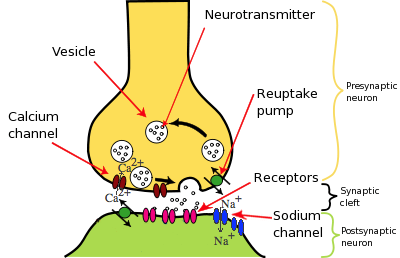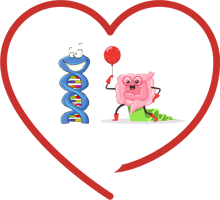DNA: I Am Who I Am… or Am I? – Session Eight
- Home
- Blog

Tame that Emotional Roller Coaster Ride Genetic Testing for the ANK3 Gene and CACNA1C Gene
Featuring “DNA 4 KIDS” with “GENiE”
“I start with the premise that all human disease is genetic.”
– Paul Berg, Nobel Laureate
“DNA+Evironment+Triggers+Chance = Your Future Health.
Take Control of Your Emotional Roller Coaster through a Simple Cheek Swab Test
of the ANK3 Gene and CACNA1C Gene”– Bruce Alan Kehr, M.D.
“Now that was an emotional roller coaster.” When was the last time you heard that phrase? Perhaps you uttered it yourself after a recent viewing of a movie or play (this is the case for me—I recently watched the movie “Lion” and it left my head spinning and my heartstrings thoroughly pulled.) Or, perhaps you heard it over coffee with a friend who recently suffered a breakup: As I’ve written in previous blogs, the addictive feelings of euphoria felt in the first stage of love can string you along through every high and low. Thanks to our current cultural backdrop, from television to politics to our 24-hour-7-day-a-week schedules, “roller coaster”-like emotions are not uncommon. But most of these “wild rides” share critical key components: They have a beginning, they have an endpoint, and—crucially—they have a reason for existing that is situational, external, or otherwise outside your own mind. In other words, the roller coaster of emotions is not all that unlike the roller coasters we choose to ride during a fun day out at a theme park: While we may not fully understand the mechanics behind the ride that scares and thrills us, we have faith that someone—or something—is handling the controls and will bring us back to safety.
Emotional Roller Coaster Rides from Variants in the ANK3 Gene and the CACNA1C Gene
Unfortunately, for some individuals, their ride is out of control. Imagine a roller coaster ride that often changes direction, alters its course, and fails to let off passengers where they first got on. Chaotic. Directionless. Can you imagine being taken on one of those emotional roller coasters without being able to pinpoint a reason for the highs and lows? Worse yet, can you imagine being in the throes of the upside downs and loop-the-loops—anger, fury, elation, sadness, and everything in between—without knowing when the ride will end? (Even in the scariest of actual rides, there is a comfort we take in the understanding that the craziness will soon return to calm). For those who suffer from this chaotic scenario, caused by genetic variants in ANK3 and CACNA1C, it can feel like the roller coaster technician, the one in charge of pulling the breaks and making sure the cars don’t spin off the rails, has completely left the building, leaving the rider with a feeling of deep uncertainty and fear of what’s to come. Dear Reader, clues as to which roller coaster you or a loved one will be consigned to board, and what to do if you have boarded the wrong one, can be found from a simple cheek swab. A genetic test.
Your DNA and Mood
Let’s dig deeper into your personal genetic code. So what determines whether your roller coaster rides will be regulated or out-of-control? If you’ve been following along with our DNA series, I bet you know the answer: your genetic code. My goal in each of the posts in this series has been to emphasize that many of the genes we were born with do not wholly dictate our destiny—but to alter how our genes express themselves to promote health and well-being, we must first have an understanding of what we’re working with. Genomind’s Genetic Test —like the Genomind Pharmacogenetic (PGx) Test—allow you to “read” your genes and take action from there. To me, that’s what Whatever It Takes is all about. So this week, we’re looking at a pair of genes I’ll call the Roller Coaster Genes: ANK3 and CACNA1C.
The ANK3 Gene and Why ANK3 Genetic Testing Should Be In Your Future if You Suffer from Mood Swings or Depression
Before I jump into the description of the ANK3 Gene, I want to give you some context: Much of the work our body does when it comes to mood and emotional stability and regulation happens in brain circuits and systems comprised of our neurons—the brain cells themselves—and synapses—the “connection” between those brain cells. “Mood-regulating” messages are received and transmitted via a process called “action potential firing and neurotransmission”. Not dissimilar to an airport terminal, there are many routes through which those messages can be sent. Some of those routes are called “ion channels” which convert chemical messages into electrical signals. Here is a picture that depicts what I am describing, with sodium and calcium ion channels (and the reuptake pump from last week’s blog 😊).

Can you imagine landing a plane on a bumpy tarmac? Certain genetic variants in your ion channels can lead to a similar emotional result: you’ll be in for a bumpy ride, to say the least. With all this in mind, let’s now return to ANK3, a gene responsible for the maintenance of your sodium ion channels. If you are born with a normal-functioning ANK3 gene, your channels will offer smooth rides. But if you are born with a mutation of this gene, your cells’ action potential firing (that is, the message transmission process) may have some level of dysfunction, and be “over-excitable,” causing excessive electrical signaling.
Now, back to our roller coasters. In normal action potential firing, when an external stimulus—like a movie or a breakup—causes messages to fire through the circuits of our brain at an extreme rate, the effectiveness of our sodium channels is what allows our cells to bring us back to normal emotional levels. But if our sodium channels are causing some “misfiring”, then our emotional roller coaster rages on and on. Because of the mood dysregulation it causes, leading scientists are now hypothesizing that the ANK3 gene plays a key role in not just the regulation of moods, but—if mutated—could potentially be a genetic contributor to bipolar disorder: an emotionally wild ride that can be extremely painful to suffer from.
By participating in an ANK3 gene test, you may be able to pinpoint right down to the gene the reason for your own mood instability—and from there, you can seek the treatment you need, which might include one or more of the following: Omega 3, Red Grape Polyphenols (Resveratrol, Quercetin, Catechin), Lithium, Topiramate, Carbamazepine, or Lamictal.
The CACNA1C Gene and Why CACNA1C Genetic Testing Can Inform the Treatment of Unstable Moods, including Bipolar Disorder
Now that you know a little bit about ion channels and their relationship to our synapses—where that message-transmission occurs—let me tell you a little bit about the CACNA1C gene, which is responsible for encoding the calcium ion channels on our brain cells. As with the ANK3 gene, variations of CACNA1C can lead to some irregularities in the way our neurons communicate messages between cells and within brain circuits. Our ion channels remain open and closed depending on the messages that are coming in or out of our cells. A mutation of our CACNA1C gene can lead to these channels remaining open for an extended period of time again creating “excitatory signaling” (“too much electricity”), which begins to negatively affect mood and anxiety—and disrupts one’s thinking and memory functions. Imagine that the little green dot in your Facebook Messenger—the one that tells your friends that you’re online and available to chat—was on almost all the time. I bet you’d get a lot more messages from your friends than if you were away from your computer. That’s what happens in this case, too: Too many messages mean your brain and your consciousness begin to get overwhelmed and confused about what it needs to respond to, and to what extent. Your brain gets too “noisy” and the emotional roller coaster ride goes on, and on, and on, with no rhyme or reason. The CACNA1C gene has been hypothesized to have a connection not just to mood instability and bipolar disorder—but also to schizophrenia. Perhaps you can see why: A mutation of this gene does not make it easy to fully grasp reality—when too many signals are coming in, the messages become muddled.
Just as with the ANK3 gene, by participating in a CACNA1C gene test, you and your doctor can work together to assess whether your mood instability may need to be addressed through epigenetic modifiers, possibly to include Lithium, Lamictal, Omega 3, Red Grape Polyphenols—(Resveratrol, Catechins, Quercetin), Nimodipine, or Namenda.
DNA 4 KIDS with Dr. Mark Novitsky

Hello Kids, it’s your friend GENiE here. I’ve enjoyed your company on this incredible journey over the last few weeks… To review, we’ve learned about the SLC6A4 Gene, MTHFR Gene, and BDNF Gene. This week we will be learning about two EXCITING genes, the ANK3 Gene and CACNA1C Gene. But to explain how these two work let me take you on a trip down memory lane…

When I was just a young GENiE, we used to play a game in school called “Telephone”. (Some of my friends have also called the game “Whisper Down the Lane”). In this game, one person whispers a phrase in the ear of the next person, who in turn passes the message on to the next person… and this continues all the way down the line until the last person announces the message whispered in his or her ear. Often this message can get a little bit jumbled by the time the last person receives it, but remarkably our bodies do an amazing job with communicating messages.
In our body, the ANK3 gene and CACNA1C gene help ensure that messages are sent from one place to another. Some people are born with ANK3 and CACNA1C genes that are “too excited” and throw off the message. This would be like playing a game of “Telephone” and instead of one person whispering in your ear, you would have five or six people whispering different messages at the same time. As you might imagine, this can help bring about a lot of emotional upset. It doesn’t “cause” your emotions but can exaggerate them.
Luckily, we can do genetic testing to identify if there are issues with these two excitatory genes. This allows us to change the “rules of the game” with ANK3 and CACNA1C by allowing us to quiet these distractions to mere “whispers” down the Brain.
Is DNA Your Destiny? Take Charge of Your ANK3 Gene and CACNA1C Gene Expression
Reader, knowledge is power, and to do whatever it takes to make you feel whole, and better than ever before, you can benefit from knowing how your DNA influences your brain, and the rest of your body, too. Take a genetic test, determine your personal genome, and begin to positively influence your future health through Actionable Genomics. Take charge now!

DNA: I Am Who I Am… or Am I? Blog Series
- Does DNA Determine My Destiny?
- Tinker with Your Genes to Determine Your Destiny
- A Simple Cheek Swab Brings Good Karma
- Test Your DNA to Determine Your Reality
- The BDNF Gene: Use “Fertilizer” to Grow a Majestic ”Rainforest Brain”… and Introducing “GENiE” and “DNA 4 KIDS”
- The MTHFR Gene: “Manufacture” Your Way to Health and Happiness Featuring “DNA 4 KIDS” with “GENiE”
- The SLC6A4 Gene (Serotonin Reuptake Gene): Improve Your Mood and Anxiety through a Simple Cheek Swab Featuring “DNA 4 KIDS” with “GENiE”
- Tame that Emotional Roller Coaster Ride Genetic Testing for the ANK3 Gene and CACNA1C Gene Featuring “DNA 4 KIDS” with “GENiE”
- Is Addiction Inherited? Genetic Testing for the OPRM1 Gene, Opioid Abuse, and Alcoholism Featuring “DNA 4 TEENS” With “GENiE”
- Surf’s Up: Use Your Genetic Code to Ride the Stress Wave with Ease The COMT Gene Featuring “DNA 4 KIDS” With “GENiE”
- Mental Illness is not a Myth—and Human Genomics Proves It The DRD2 Gene and Dopamine Featuring “DNA 4 KIDS” With “GENiE”
- ADHD in the Age of Distraction The Tricky Genetics behind ADHD and ADRA2A Featuring “DNA 4 KIDS” With “GENiE”
- Overweight and Obesity – Is it Me, or My DNA? 5HT2C and MC4R: Can Your Genes Make You Fat?
- Is Alcoholism Inherited? Can a Tiny Gene Help Treat It? The GRIK1 Gene
- 2018 Women’s Health and Wellness Summit DNA Keynote Address
Related Information
- Learn about Genetic Testing
- Learn about Potomac Psychiatry
- Meet Our Doctors
- Contact Potomac Psychiatry
.png?width=144&height=144&name=Untitled%20design%20(34).png)



